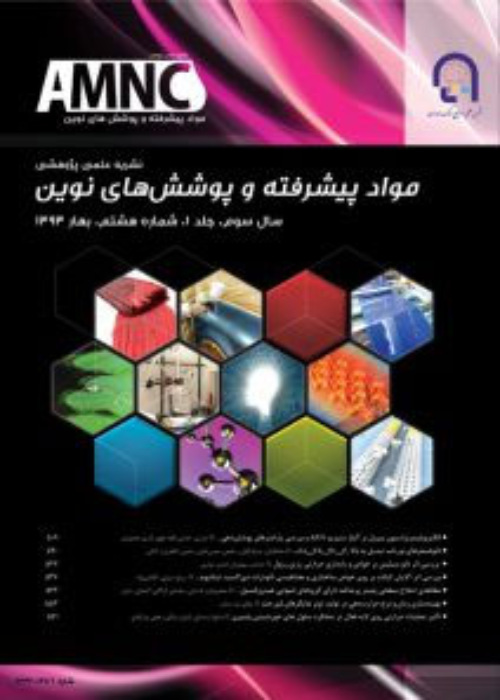فهرست مطالب
فصلنامه مواد پیشرفته و پوشش های نوین
پیاپی 1 (تابستان 1391)
- تاریخ انتشار: 1391/08/15
- تعداد عناوین: 7
-
-
Page 3The effect of surfactant on the luminescent intensity of Y2O3:Eu3+ nano particles is described. Three kinds of different surfactants were used to synthesis Y2O3:Eu3+ nano particles via a simple modified precipitation process. These surfactants are PEG-g- Acrylic comb which are different from each other by the number of repeated groups. The results demonstrated that the number of repeated groups had a significant influence on the morphology and particle size distribution and consequently, the photoluminescence intensity will be changed. The SEM and TEM results showed that morphology of particles is changing from irregular shape to semi sphere one by using these surfactants. The other results showed that the precipitation temperature had vital effect on morphology and particle size.Keywords: Precipitation, Surfactant, Luminescent, Yttrium oxide, Morphology, Nanoparticles
-
Page 15In this paper, chitosan (Ch) as a biopolymer is modified by Ethyl acrylate (Ea) and is utilized for dye removal from colored textile effluent containing of C.I. Basic Violet 16 (BV16). The achieved component was characterized by analyzing Fourier Transform Infra-Red spectroscopy (FTIR). The results confirmed that the spectroscopic data had a good relation to chemical structure of synthesized component. The consideration of dye removal properties of prepared adsorbent, the influence process variables such as pH, adsorbent dosage, dye concentration, temperature, contact time and inorganic salts were studied. It was found out that the dye removal increased by rising of pH; contact time and adsorbent dosage, whereas decreased by addition inorganic salts and increasing of the dye concentration. The obtained results showed that the capacity of the dye adsorption for BV16 onto modified chitosan increased. The pseudo-first order, pseudo-second order kinetic and intraparticle diffusion models were used to describing the kinetic data and finally, the experimental data fitted well to pseudo-second order kinetic model. Equilibrium isotherms were analyzed by Langmuir, Freundlich and Temkin adsorption models and the dye adsorption was correlated reasonably well by Langmuir isotherm. The results demonstrated that Ch-g-Ea could be employed as an affective biopolymer for removal of basic dyes from colored textile effluents.Keywords: Biopolymer, Chitosan, Dye removal, Basic dye, Adsorption Kinetic, Adsorption Isotherm
-
Page 27In this article, lithium zinc phosphate pigment was synthesized via co-precipitation method and anticorrosion properties of the product were investigated. The synthesized pigment was characterized by x-ray diffraction (XRD) and Fourier transform infrared (FTIR). Morphology of the powders was examined by scanning electron microscope (SEM). The inhibition efficiency of this pigment was compared to the commercial zinc phosphate pigment in a 3.5 % NaCl solution by means of electrochemical impedance spectroscopy (EIS) on mild steel specimens. The XRD results revealed that LiZnPO4 presents as major phase and LiZn2PO4.HPO4 and ZnO are as minor phases. The EIS results indicate better corrosion inhibitive performance of potassium zinc phosphate in comparison with the commercial zinc phosphate.Keywords: Lithium zinc phosphate, Anticorrosion properties, Characterization, EIS, Synthesis
-
Page 35The corrosion stability of epoxy coating protective system on carbon steel strongly related to the strength of bonds forming at the metal/organic coating interface. In this work, surface modification of carbon steel substrates using appropriate acid and alkaline treatment was carried out to investigate their effect on the interfacial properties of carbon steel/epoxy.The 0.1M HCl and 0.15M Na2B4O7.10H2O + 0.6M H3BO3 solutions were used for acid and alkaline treatment, respectively. Microscopic and electrochemical impedance spectroscopy methods have been used to investigate the effect of the chemical treatments on the interfacial adhesion of the epoxy/carbon steel. It has been shown that both chemical treatments increased the epoxy/carbon steel adhesion during exposure to 5%NaCl solution. The results indicated that 0.1M HCl treatment provided the highest epoxy/carbon steel wet adhesion.Keywords: Interface, Surface treatment, Corrosion, Coating, Carbon steel
-
Page 41In this research, a novel dye based on N-allylnaphthalimide containing thiourea was synthesized and its properties as fluorescent sensor and colorimetry for fluoride ion were studied in DMF solution. Results reveal that the fluorescence emissions of the dye were only ‘switched off ‘in the presence of fluoride ion. The dye also showed remarkable spectral shifts in visible region by adding the fluoride ions, also, green-yellow to purple color changes occurs. Thus it could serve as a colorimetric and fluorescent sensor for fluoride ion.Keywords: Allyl naphthalimide, Dye, Fluorescent sensor, Fluoride ion, Colorimetry
-
Page 49In present investigation the effect of calcination time of nano-sized CoAl2O4 pigment on thermal behaviour of a typical transparent frit was investigated. The nano-sized cobalt-aluminate spinels were prepared by combustion method and calcined for 1 and 2 h at 800 and 1000 ˚C. The calcined powders were added to an industrial transparent frit and the thermal behaviours of modified glazes were studied by hot stage microscopy, HSM. The thermal properties are described in terms of height percentage and contact angle as a function of temperature. In order to obtain the parameters of Vogel-Fulcher-Tamman equation, the glass transition temperature, softening point and the temperature where samples form a half-sphere shape during HSM analysis were measured and the molten phase viscosity was predicted as a function of temperature. The results indicated that the calcination of cobalt–aluminate at 1000 ˚C during 1 h provides the best thermal properties.Keywords: Transparent glaze, Cobalt, aluminate, Combustion, Hot stage microscopy, Contact angle
-
Page 63In this article, the curing of the one component polyurethane coatings has been investigated. In order to separate different reactions during curing of the coatings, deblocking reaction has been studied using FTIR spectroscopy firstly. after that the curing reactions studied using thermal analysis. The results show that the curing reactions have two different parts, at first step the deblocking occurs, so the concentration of NCO increases rapidly and after \ that it\ deacreases because of evaporation and some of side reactions. The maximum of released NCO groups were observed at the temperature of 150 oC. It was concluded that the deblocking and curing steps were highly temperature dependent.Keywords: Blocked isocyanates, Polyurethane coatings, Thermal analysis, Epoxy amine adduct


